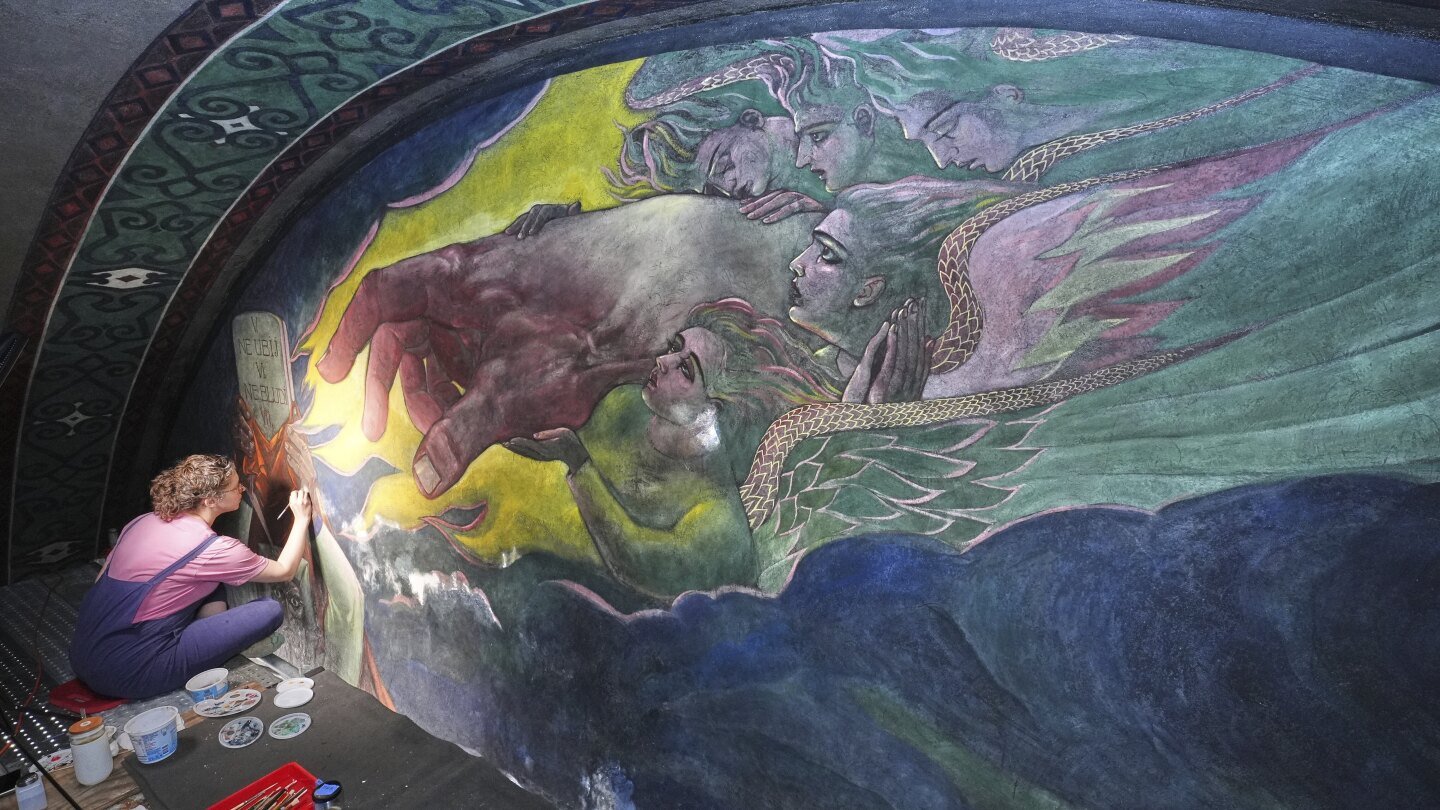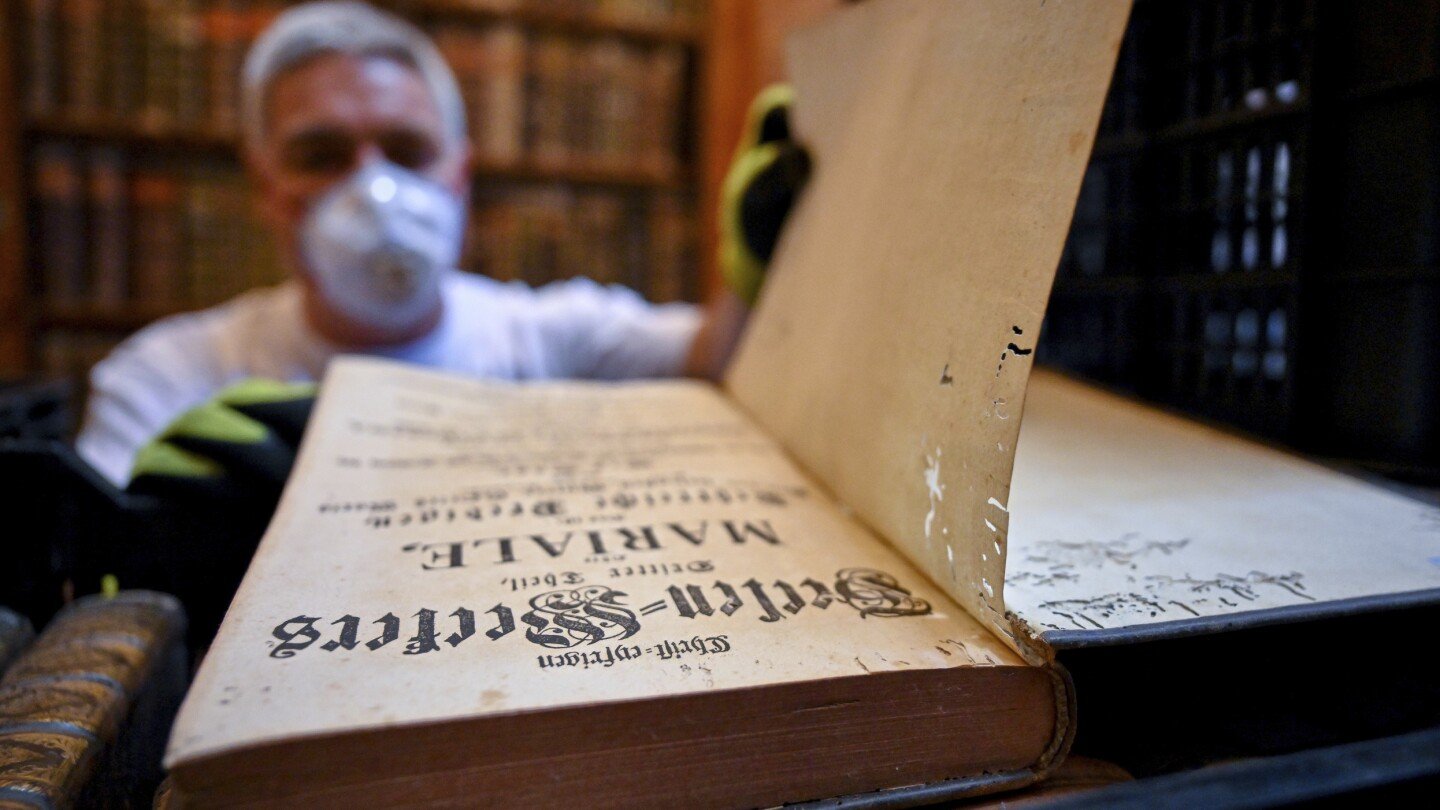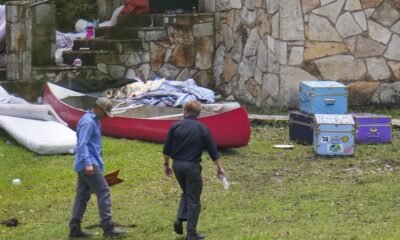Lifestyle
Famed church murals preserved in Pittsburgh

MILLVALE, Pa. (AP) — When the scaffolding came down inside the unassuming hilltop church near Pittsburgh, it revealed a raging storm of biblical proportions.
A wide-eyed Moses holds the Ten Commandments aloft in righteous fury, ready to shatter the tablets when his followers abandon God for a golden calf. Lightning sizzles and a tornado surges in the background.
The late artist Maxo Vanka created the mural in 1941, based on a scene from the Book of Exodus. It’s one of 25 murals that cover the walls and ceilings of St. Nicholas Croatian Catholic Church.
Vanka, a Croatian American immigrant like most of the original parishioners, painted the scenes in bursts of creative energy that led to marathon-long sessions where he captured stark social inequities alongside traditional religious themes.
The murals depict scenes with dualities. An angelic justice figure contrasts with a haunting figure of injustice in a World War I gas mask. Mothers — posed like the grief-stricken Madonnas of traditional pietas — weep over their sons who died in war or were worked to death by American industry. A callous tycoon ignores a beggar. A Madonna snaps a rifle on a battlefield.
At the same time, the murals honor the achievements of the immigrant parishioners and the consolations of faith, home and maternal care.
The work has drawn international visitors and become a beloved local landmark. One former priest for the church called it “The Sistine Chapel of Pittsburgh”— a sanctuary dominated by the single artist’s tour-de-force.
But decades of smoke, atmospheric salts and water leaks had dulled and damaged the paintings.
Since 2009, the Society to Preserve the Millvale Murals of Maxo Vanka has been leading a painstaking conservation effort — one section at a time.
Results of the latest work completed in late May are evident.
The paint in Moses’ florid cheeks and deeply grooved facial lines now stand out starkly. Behind him, the large hand of God now gleams brighter. So too do the hair and flamelike feathers of onlooking angels, painted in Vanka’s unique palette of bright pink and sea-foam green.
“It’s like seeing it how he really wanted it for the first time,” Vanka’s granddaughter, Marya Halderman, said of the conservation work earlier this year. “He always called it his gift to America.”
Over four months, a team of more than a dozen workers climbed a 32-foot (9.8-meter) scaffold to clean off grime, extract corrosive salts from the walls, stabilize plaster and delicately fill in areas of lost paint with new pastels and watercolors, which can easily be reversed by current or future conservators.
They worked to reveal the artist’s original work, including the vigorous brushstrokes he applied amid long hours that stretched into the night, when Vanka reported eating little food, consuming much coffee and often seeing a ghost.
The murals “speak to a unique time in history, World War II and immigration and social justice,” says the Rev. Nicholas Vaskov, director of the Shrines of Pittsburgh, a cluster of historic Catholic parishes that includes St. Nicholas. “To allow them to continue to speak to people and to see that they are preserved is a great gift.”
In January, the crew worked a section that includes the tempestuous Moses and two Gospel scribes in placid poses, St. Matthew and St. Mark.
“One of my favorite things about being a conservator is that I get to touch things that no one has been able to touch for over, what, 70 years?” says Naomi Ruiz, a wall paintings expert. “You really get to see the artist’s brushstrokes, his original hand, his struggle when he’s trying to reach off of his scaffold to reach that last little part. It makes you even want to work harder and longer.”
Challenges loomed. They were working on the side of the church that takes the most sunlight, which has caused more damage, from fluctuations in temperature and humidity.
An artist who crossed social classes
Maksimilijan Vanka was born in 1889 in what is now independent Croatia.
An out-of-wedlock son of nobility, Vanka was raised by a peasant woman, Dora Jugova. She became the prototype for Vanka’s recurring artistic motif of strong, maternal and pious women — such as the sturdy Madonna he depicted with work-worn hands in one of the church’s most prominent murals.
Vanka’s noble family eventually provided him an education. His familiarity with both privilege and poverty gave him insight and sensitivity to people across social classes.
Vanka studied in Belgium and served with the Red Cross during World War I. He immigrated to the United States in the 1930s after marrying an American, Margaret Stetten.
A Pittsburgh exhibit of Vanka’s art caught the attention of the late Rev. Albert Zagar, pastor of St. Nicholas. The church had been rebuilt after a fire, its walls now blank and waiting for the right artist.
“They’d found their person,” said Anna Doering, executive director of the Society to Preserve the Millvale Murals of Maxo Vanka.
Vanka transformed the sanctuary in two intense seasons of creativity, in 1937 and 1941.
He fused traditional Catholic iconography with searing commentary on war, capitalism, and immigrant labor and contrasting depictions of communal piety and economic greed.
“It’s religion, expressed in our social life,” Zagar said in 1941. “At the same time, it’s completely Catholic.”
Vanka continued his artistic career until his tragic death in 1963, when he drowned off the coast of Mexico while on vacation.
Preserving a local treasure
In the decades since, parishioners have cherished the murals, caring for them as best they knew how.
More formal conservation efforts began in 1991, when the artist’s admirers formed the Society to Preserve the Millvale Murals of Maxo Vanka. By 2009, the society was ready to launch professional work in earnest — preserving one mural at a time.
Doering recalls when she first set foot in the church as a consultant.
“My jaw just dropped,” she said. “I had never seen anything like this. And I wanted to be part of it.”
Locals and foundations alike donated. The society also worked with the parish to repair the roof and upgrade climate control systems.
In 2022, the society was awarded a $471,670 grant through the Save America’s Treasures program, administered by the National Park Service, enabling recent work on the upper part of the church.
A process of art and science
The conservation workers began by brushing and vacuuming off loose dirt and soot. They did further cleaning with sponges and cotton swabs by the thousands.
Much of the grime, Ruiz said, likely resulted from years of atmospheric pollution, ranging from Pittsburgh’s former steel mills to everyday highway traffic.
The crew also worked to reverse damage to the plaster caused by atmospheric salts.
For Ruiz, the murals have universal themes.
“This story that Vanka was telling was specifically for the Croatian people, but it could also speak towards many immigrant families here in the U.S. and how they felt and how they brought a lot of their culture with them,” she said.
An unusual field trip
Along with conservation work, the society does educational outreach, bringing in student field trips in tandem with the LIGHT Education Initiative, a Pittsburgh-area program with a mission to equip “the next generation of humanitarians.”
Becky Gaugler, director of education and interpretation for the preservation society, welcomed visiting sixth graders from a nearby school earlier this spring. She told them the murals show “how we can talk about our own stories in relation to those stories in the past.”
One student group gathered beneath two contrasting dinner scenes. In one, a modest family prays over a simple meal of bread and soup. In another, a top-hatted millionaire dines alone, indifferent to the beggar at his feet as an angel weeps.
The students debated which table they’d rather join. The rich man has better food, they noted, but the family appears more hospitable.
“They are very grateful obviously for what they have,” observed sixth-grader Corinne Coppler.
Seeing the big picture
Vaskov said the murals remain central to the parish’s identity. Though most services are now in English, the parish still holds a monthly Croatian-language Mass and celebrates other ethnic traditions.
The scaffolding supporting the conservation work posed “a temporary inconvenience to reveal something marvelous,” Vaskov said.
It finally came down in late May, in time for the parish’s 125th anniversary Mass on June 1. Most of the murals have now undergone conservation. More work lies ahead, but it made an opportunity to savor the latest results.
“When you’re up there, you really get caught up in every little spot,” Ruiz said. “Then I look at the big picture. It’s so much better than how it was four months ago. It looks so solid. All the colors just pop.”
___
AP photographer Gene Puskar and AP videographer Jessie Wardarski contributed.
___
Associated Press religion coverage receives support through the AP’s collaboration with The Conversation US, with funding from Lilly Endowment Inc. The AP is solely responsible for this content.
Lifestyle
Hungary’s oldest library is fighting to save 100,000 books from a beetle infestation

PANNONHALMA, Hungary (AP) — Tens of thousands of centuries-old books are being pulled from the shelves of a medieval abbey in Hungary in an effort to save them from a beetle infestation that could wipe out centuries of history.
The 1,000-year-old Pannonhalma Archabbey is a sprawling Benedictine monastery that is one of Hungary’s oldest centers of learning and a UNESCO World Heritage site.
Restoration workers are removing about 100,000 handbound books from their shelves and carefully placing them in crates, the start of a disinfection process that aims to kill the tiny beetles burrowed into them.
The drugstore beetle, also known as the bread beetle, is often found among dried foodstuffs like grains, flour and spices. But they also are attracted to the gelatin and starch-based adhesives found in books.
They have been found in a section of the library housing around a quarter of the abbey’s 400,000 volumes.
“This is an advanced insect infestation which has been detected in several parts of the library, so the entire collection is classified as infected and must be treated all at the same time,” said Zsófia Edit Hajdu, the chief restorer on the project. “We’ve never encountered such a degree of infection before.”
Abbey houses historical treasures
The beetle invasion was first detected during a routine library cleaning. Employees noticed unusual layers of dust on the shelves and then saw that holes had been burrowed into some of the book spines. Upon opening the volumes, burrow holes could be seen in the paper where the beetles chewed through.
The abbey at Pannonhalma was founded in 996, four years before the establishment of the Hungarian Kingdom. Sitting upon a tall hill in northwestern Hungary, the abbey houses the country’s oldest collection of books, as well as many of its earliest and most important written records.
For over 1,000 years, the abbey has been among the most prominent religious and cultural sites in Hungary and all of Central Europe, surviving centuries of wars and foreign incursions such as the Ottoman invasion and occupation of Hungary in the 16th century.
Ilona Ásványi, director of the Pannonhalma Archabbey library, said she is “humbled” by the historical and cultural treasures the collection holds whenever she enters.
“It is dizzying to think that there was a library here a thousand years ago, and that we are the keepers of the first book catalogue in Hungary,” she said.
Among the library’s most outstanding works are 19 codices, including a complete Bible from the 13th century. It also houses several hundred manuscripts predating the invention of the printing press in the mid-15th century and tens of thousands of books from the 16th century.
While the oldest and rarest prints and books are stored separately and have not been infected, Ásványi said any damage to the collection represents a blow to cultural, historical and religious heritage.
“When I see a book chewed up by a beetle or infected in any other way, I feel that no matter how many copies are published and how replaceable the book is, a piece of culture has been lost,” she said.
Books will spend weeks in an oxygen-free environment
To kill the beetles, the crates of books are being placed into tall, hermetically sealed plastic sacks from which all oxygen is removed. After six weeks in the pure nitrogen environment, the abbey hopes all the beetles will be destroyed.
Before being reshelved, each book will be individually inspected and vacuumed. Any book damaged by the pests will be set aside for later restoration work.
Climate change may have contributed
The abbey, which hopes to reopen the library at the beginning of next year, believes the effects of climate change played a role in spurring the beetle infestation as average temperatures rise rapidly in Hungary.
Hajdu, the chief restorer, said higher temperatures have allowed the beetles to undergo several more development cycles annually than they could in cooler weather.
“Higher temperatures are favorable for the life of insects,” she said. “So far we’ve mostly dealt with mold damage in both depositories and in open collections. But now I think more and more insect infestations will appear due to global warming.”
The library’s director said life in a Benedictine abbey is governed by a set of rules in use for nearly 15 centuries, a code that obliges them to do everything possible to save its vast collection.
“It says in the Rule of Saint Benedict that all the property of the monastery should be considered as of the same value as the sacred vessel of the altar,” Ásványi said. “I feel the responsibility of what this preservation and conservation really means.”
Lifestyle
Osprey are declining and environmentalists blame fishing industry’s take of menhaden

GLOUCESTER POINT, Va. (AP) — Stepping onto an old wooden duck blind in the middle of the York River, Bryan Watts looks down at a circle of sticks and pine cones on the weathered, guano-spattered platform. It’s a failed osprey nest, taken over by diving terns.
“The birds never laid here this year,” said Watts, near the mouth of Virginia’s Chesapeake Bay. “And that’s a pattern we’ve been seeing these last couple of years.”
An osprey is silhouetted as it perches atop a nest on the Lynnhaven River, June 30, 2025, in Virgina Beach, Va. (AP Photo/Stephanie Scarbrough)
Watts has a more intimate relationship with ospreys than most people have with a bird — he has climbed to their nests to free them from plastic bags, fed them by hand and monitored their eggs with telescopic mirrors.
The fish-eating raptor known for gymnastic dives and whistle-like chirps is an American conservation success story. After pesticides and other hazards nearly eliminated the species from much of the country, the hawk-like bird rebounded after the banning of DDT in 1972 and now numbers in the thousands in the U.S.
An osprey flies with a half-eaten fish in its talons above the Lynnhaven River, June 30, 2025, in Virginia Beach, Va. (AP Photo/Stephanie Scarbrough)
But Watts has documented an alarming trend. The birds, which breed in many parts of the U.S., are failing to successfully fledge enough chicks around their key population center of the Chesapeake Bay. The longtime biologist blames the decline of menhaden, a small schooling fish critical to the osprey diet. Without menhaden to eat, chicks are starving and dying in nests, Watts said.
Osprey are an environmental indicator
Watts’s claim has put him and environmental groups at odds with the fishing industry, trade unions and sometimes government regulators. Menhaden is valuable for fish oil, fish meal and agricultural food as well as bait.
U.S. fishermen have caught at least 1.1 billion pounds of menhaden every year since 1951. Members of the industry tout its sustainability and said the decline in osprey may have nothing to do with fishing.
But without help, the osprey population could tumble to levels not seen since the dark days of DDT, said Watts, director of the Center for Conservation Biology at The College of William & Mary in Williamsburg, Virginia.
Brian Watts, research professor and director of the Center for Conservation Biology at The College of William & Mary, looks over at failed osprey nest atop a wooden duck blind on the Lower York River, June 30, 2025, in Gloucester Point, Va. (AP Photo/Stephanie Scarbrough)
“The osprey are yelling pretty loudly that, hey, there’s not enough menhaden for us to reproduce successfully,” Watts said. “And we should be listening to them to be more informed fully on the fisheries side, and we should take precaution on the fisheries management side. But that hasn’t won the day at this point.”
Decline linked to menhaden in studies
Watts, who has studied osprey on the Chesapeake for decades, has backed his claims of population decline by publishing studies in scientific journals. He said it boils down to a simple statistic — to maintain population, osprey pairs need to average 1.15 chicks per year.
Osprey were reproducing at that level in the 1980s, but today in some areas around the main stem of the Chesapeake, it’s less than half of that, Watts said. In particularly distressed areas, they aren’t even reproducing at one-tenth that level, he said. And the decline in available menhaden matches the areas of nesting failure, Watts said.
A bald eagle, left, steals a fish from an osprey before it could feed above the Lynnhaven River, June 30, 2025, in Virginia Beach, Va. (AP Photo/Stephanie Scarbrough)
Also called pogies or bunkers, the oily menhaden are especially important for young birds because they are more nutritious than other fish in the sea. Osprey “reproductive performance is inextricably linked to the availability and abundance” of menhaden, Watts wrote in a 2023 study published in Frontiers in Marine Science.
Conservationists have been concerned for years, saying too many menhaden have been removed to maintain their crucial role in the ocean food chain. Historian H. Bruce Franklin went so far as to title his 2007 book on menhaden “The Most Important Fish In The Sea.”
Fishing industry pushes back
Menhaden help sustain one of the world’s largest fisheries, worth more than $200 million at the docks in 2023. Used as bait, the fish are critical for valuable commercial targets such as Maine lobster. They’re also beloved by sportfishermen.
The modern industry is dominated by Omega Protein, a Reedville, Virginia, company that is a subsidiary of Canadian aquaculture giant Cooke. The company pushed back at the idea that fishing is the cause of osprey decline, although it did acknowledge that fewer menhaden are showing up in some parts of the bay.
Federal data show osprey breeding is in decline in many parts of the country, including where menhaden is not harvested at all, said Ben Landry, an Omega spokesperson. Climate change, pollution and development could be playing a role, said Landry and others with the company.
Blaming fishing “just reeks of environmental special interest groups having an influence over the process,” Landry said.
New rules could be on the way
The menhaden fishery is managed by the Atlantic States Marine Fisheries Commission, an interstate body that crafts rules and sets fishing quotas. Prompted by questions about ospreys, it created a work group to address precautionary management of the species in the Chesapeake Bay.
A young osprey returns to its nest on the Lynnhaven River, June 30, 2025, in Virginia Beach, Va. (AP Photo/Stephanie Scarbrough)
In April, this group proposed several potential management approaches, including seasonal closures, restrictions on quotas or days at sea, and limitations on kinds of fishing gear. The process of creating new rules could begin this summer, said James Boyle, fishery management plan coordinator with the commission.
The osprey population has indeed shown declines in some areas since 2012, but it’s important to remember the bird’s population is much larger than it was before DDT was banned, Boyle said.
“There are big increases in osprey population since the DDT era,” Boyle said, citing federal data showing a six-fold increase in osprey populations along the Atlantic Coast since the 1960s.
Environmentalists says bird’s decline could worsen
To a number of environmental groups, any decline is too much. This irritates some labor leaders who worry about losing more jobs as the fishing industry declines.
Kenny Pinkard, retired vice president of UFCW Local 400’s executive board and a longtime Virginia fishermen, said he feels the industry is being scapegoated.
“There are some people who just don’t want to see us in business at all,” he said.
But Chris Moore, Virginia executive director for Chesapeake Bay Foundation, said the country risks losing an iconic bird if no action is taken. He said Watts’s studies show that the osprey will fail without access to menhaden.
“Osprey have been a success story,” Moore said. “We’re in a situation where they’re not replacing their numbers. We’ll actually be in a situation where we’re in a steep decline.”
___
Whittle reported from Portland, Maine.
___ This story was supported by funding from the Walton Family Foundation. The AP is solely responsible for all content.
Lifestyle
Cooling gadgets and wearables can help you beat the heat

You can only sit in front of the fridge with the door open for so long.
As heat waves blast the world like a blow dryer on high, folks are reaching for anything that promises a little personal chill: portable mini fans, cooling neck wraps, high-tech vests and all kinds of heat-beating headwear.
Of course, cooling gear helps most when paired with basic and safe strategies against the heat: most importantly hydration, shade and rest. Stay out of extreme heat when possible, and know the signs of heat exhaustion or heat stroke.
Yet these wearable wonders and breezy gadgets can offer some relief. They might look quirky, but when the AC struggles and the sidewalk feels like a stovetop, they can start to seem like must-haves.
When you’re at home
Indoors, stay comfy with cool-feel sheets (like those with a silky finish or lightweight fibers), bed fans (where a nozzle inserted into the bed linens pumps a flow of air around you), or a cooling pillow or chill pad, which are filled with a gel that can stay cool for hours. Sleep-product brands include Serta, Sealy, Casper, Pluto and Threshold.
The chill pads can work for your own bed and the pets’ bed too. There are chillable full-size mattresses (Chilipad, 8Sleep and BedJet get good reviews from The Spruce) and smaller, simple pads (CoolCare and Sharper Image, among others).
Outdoor wearables
Clare Epstein, an employee safety expert with Vector Solutions in Tampa, Florida, works to reduce heat stress for at-risk employees in industries like construction, aviation and agriculture. She recommends wearables like cooling scarves and evaporative cooling vests.
“By soaking the fabric in cold water at the beginning of the day, the vest slowly cools, and keeps the wearer cool,” she says.
Clothes made of “phase change materials,” or PCMs, contain gel capsules or pads that can help moderate body temperatures. Uline.com advertises a vest that stays under 60 degrees for a few hours, and AlphaCool offers a neck tube that performs similarly. Another feature of the tube, which is made of a polymer material, is that it doesn’t get overly chilled, so it’s safe for kids to use.
Also for kids, there’s a line of plush toys from Warmies that includes little critters of the farmyard, ocean, forest and safari that can be popped in the freezer before a trip to the park or playground.
Wearable items that incorporate small fans or thermoelectric coolers are also good, Epstein says. And there are vests with tubed reservoirs you can fill with water or electrolytes so you can sip as you go.
“These encourage people to take more water breaks, and stay hydrated,” says Epstein.
The wearables range is extensive. Along with cooling buffs, headbands, wristbands, socks and scarves, there are cooling brimmed hats and ball caps. Brands include Mission, Ergodyne, and Sunday Afternoon.
If you’d prefer a refreshing breeze, USB-chargeable handheld or wearable fans might do the job.
Chill advice
Lynn Campbell, co-founder of 10Adventures travel company in Calgary, Alberta, takes a lot of strenuous hiking and cycling trips with her husband, Richard. They’ve developed some easy hacks for hot days.
“We’ll wake up early, so we’re done by 10 or 11 a.m., or if we’re out on the trails, split the day in two, so we rest by water or in the shade over the hottest part” of the day, she says.
Wear light colors and thin, breathable fabrics.
And bring an umbrella. “This is a game-changer,” Campbell says. “Now we always pack ultralight, compact ones; they’re incredible.”
Also, pour cool water on your head and back. “We freeze a few bottles of water so we can pour ice water on us to cool down,” Campbell says. “Putting the bottles under the armpits, in the groin, or on the back of the neck can effectively cool a person down.”
And Annita Katee, a contributing writer for Apartment Therapy, has another way to prep your bed on hot nights:
“Pop your sheets into the freezer at least two hours before bedtime, then pull them out right before you hit the sack,” she wrote in a recent post. She folds hers into a zipped plastic bag, flattens it, then sets it on a freezer shelf between ice packs.
“The result? A delightfully cool bed that feels like a refreshing oasis against the heat.”
___
New York-based writer Kim Cook covers design and decor topics regularly for The AP. Follow her on Instagram at @kimcookhome.
For more AP Lifestyles stories, go to https://apnews.com/lifestyle
-

 Asia4 days ago
Asia4 days agoA torpedoed US Navy ship escaped the Pacific in reverse, using coconut logs. Its sunken bow has just been found
-

 Asia4 days ago
Asia4 days agoGujarat state: Bridge collapse kills 9 in India
-

 Lifestyle5 days ago
Lifestyle5 days agoFaith-based camps like those hit by Texas floods are rite of passage for many
-

 Lifestyle5 days ago
Lifestyle5 days agoPhotos show French President Emmanuel Macron’s UK state visit
-

 Lifestyle5 days ago
Lifestyle5 days agoRemoving shoes to board a plane may be a thing of the past
-

 Africa5 days ago
Africa5 days ago30% on South African imports: Ramaphosa hits back at new Trump tariffs
-

 Europe4 days ago
Europe4 days agoExtreme heat is a killer. A recent heat wave shows how much more deadly its becoming as humans warm the world
-

 Europe4 days ago
Europe4 days agoTrump promised 200 deals by now. He’s gotten 3, and 1 more is getting very close




